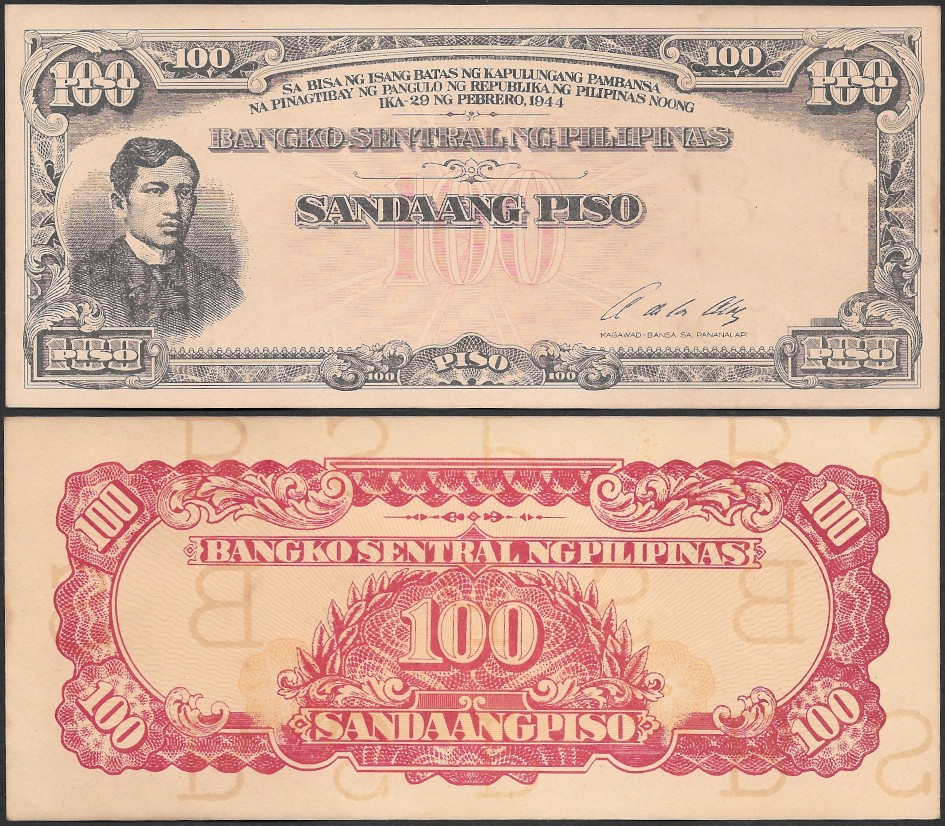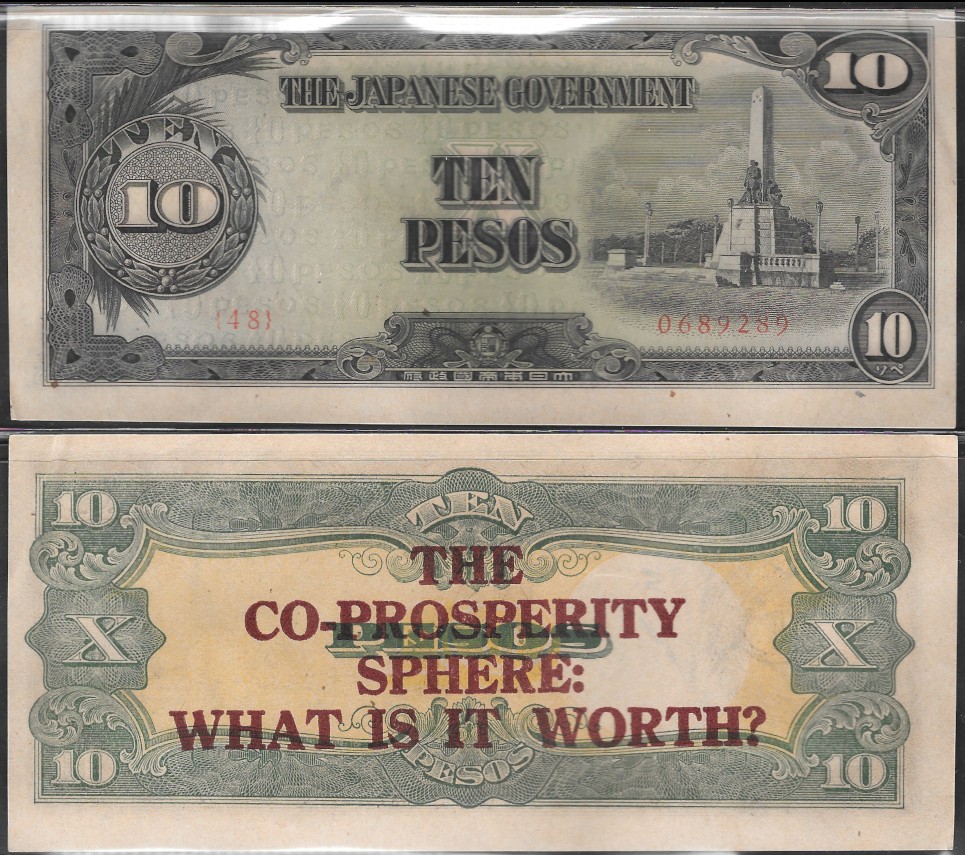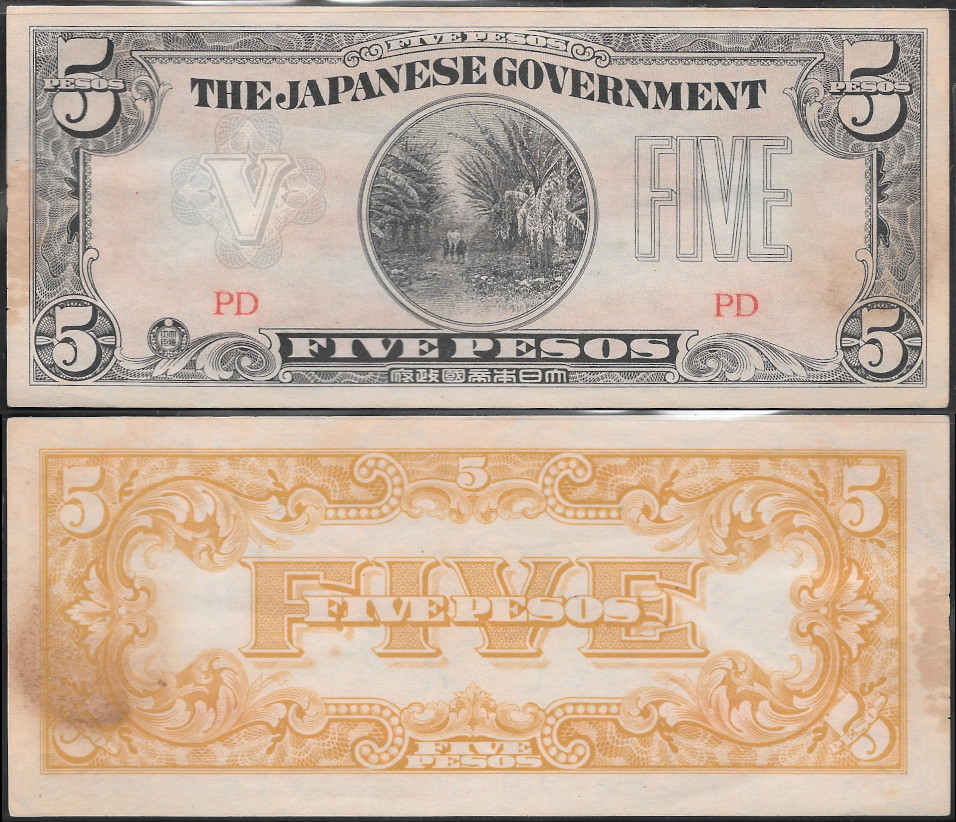Forgeries, tyranny, hyperinflation, propaganda and souvenir banknotes – all areas covered in part 6 of the History of Philippine Paper Money – WWII Japanese Invasion Money in the Philippines (1942-1945).

Japanese Invasion Money
During World War II the Japanese invaded then occupied the Philippines from 1942 to 1945. During this time they issued their own fiat currency in the form of paper notes to replace the local currency. These banknotes are often referred to as Invasion Money, JIM (Japanese Invasion Money), Japanese Pesos, Fiat Pesos or Mickey Mouse Money. To the Japanese they were officially know as Southern Development Bank Notes. The Southern Development Bank was established to provide financial services to the many areas occupied by Japan at the time.
In 1940 the Japanese Prime Minister raised the concept of the “Greater East Asia Co-Prosperity Sphere”. With Japan having taken control of so many Asian nations the concept was an “Asia for Asians”. A sphere of Asian countries led by the Japanese, free of ties to Western powers and with a unified currency. Inline with this concept the Japanese government issued two series of banknotes for the Philippines. The first was released in 1942 and the second in 1943. Additional notes in larger denominations were added in 1944 and 1945 due to experienced hyperinflation.
Upon release of the Japanese Invasion Money any prior Philippine pesos were immediately outlawed and devalued. With permission of the exiled Government of the Philippine Commonwealth many guerilla notes were produced by local banks and local governments. Often crude in nature, they did allow local Filipinos across the many islands to continue to conduct business and trade. However, possession of these notes would result in confiscation and at best a severe beating; the worst case being death by execution. Guerilla notes will be covered in the next section.
During WWII the United States counterfeited 50 centavo notes along with 1, 5 and 10 peso banknotes. Counterfeit notes were created in the United States and Australia and were dropped by air into the Philippines in an attempt to both destabilize the currency and to provide funds to Filipino Guerilla fighters. They also circulated 1 Peso propaganda notes that had been overprinted in red with the words “THE CO-PROSPERITY SPHERE. WHAT IS IT WORTH”. This was an attempt to discredit the Greater East Asia Co-Prosperity Sphere.
Japanese Invasion Money – First Series (1942)
First series Japanese Invasion Banknotes would contain block letters and/or serial numbers. Block letters were simply a ‘P’ (denoting the Philippines) followed by another letter indicating what run (and therefore when) the banknote was printed in. The letters A-Z clearly only allows 26 printing runs and this limitation soon became apparent. To compensate, fractional block letters were introduced – fractional blocks have the letter P (again denoting they were printed for the Philippines) above a line with 2 characters beneath it. The characters would start at AA, increment to AB, AC and so on. Once AZ was reached they would shift to BA then BB, BC, etc. This pattern could continue potentially all the way to ZZ. Serial numbers were introduced in the second series of banknotes in 1943.
The first series of banknotes consisted of 1, 5, 10 and 50 centavos notes along with 1, 5 and 10 peso denominations.
Note: In this series it is the 5c note (P103b) that presents the most significant challenge to the collector. Fewer notes were printed with the fractional block letters.
Japanese Invasion Money – Second Series (1943)
The second series saw the removal of all fractional notes and its lowest value note was 1 peso. Inflation was an issue and the Japanese Pesos were worth very little at the time – hence the later addition of the larger values in this series. 1, 5, 10 and 100 peso notes had both a block number and a serial number. Serial numbers typically began with a leading ‘0’ – a leading ‘1’ would represent a replacement note (similar to star notes).
Japanese Invasion Money – Replacement Notes
As indicated earlier, replacement notes for the second series can be identified by the leading ‘1’ at the start of the serial number. Note: the first series (1942) did not have serial numbers, rather block letters and as such replacement notes were not marked.

Japanese Invasion Money – Unissued Banknote from 1944
A new banknote was printed in 1944 but was never released. This banknote can be seen in various permutations – blank as shown below, with single or double MI-HON characters or with the word Specimen and serial numbers (all zeros) printed in red. The notes feature José Rizal on the obverse and a decorative red design on the reverse. The banknotes were produced by the Bangko Sentral Pilipinas (BSP). These are very scarce notes.
| Image | Denomination | Notes |
|---|---|---|
 | 100 Peso 1944 | Type P116r: No block number or serial number Unissued banknote BSP watermark clearly visible |
Co-Prosperity Notes
As indicated in the introduction, the US dropped counterfeit notes onto the Japanese-occupied Philippine Islands during WWII as a way to destabilize the economy and to distribute funds to Filipino guerilla fighters. Some of these counterfeit notes are propaganda notes with a simple message printed in a large red font – “THE CO-PROSPERITY SPHERE: WHAT IS IT WORTH?”.


After WWII
House bill no 647 “An Act Governing the Payment of Monetary Obligations Incurred or Contracted Prior to and During the Japanese Invasion of the Philippines and for Other Purposes” was approved in 1946. Philippine President Sergio Osmena signed off on this act despite U.S. President Truman not supporting the bill. The bill essentially ensured that contracts and other incurred monetary obligations along with any payments made in Japanese Pesos during WWII were considered valid. Note: all Japanese Invasion Money was devalued after WWII, this Act was more about ensuring the legitimacy of contractual obligations.
Red Cross Punched Notes
After WWII the Red Cross was helping with recovery efforts in the Philippines. During which time they amassed a large quantity of Japanese Invasion Money. They proceeded to punch 2 holes in each note and handed them out to soldiers as souvenirs.







You often see notes on eBay for sale with 2 holes punched out of them – often described as “cancelled notes”. I would caution against overpaying for these notes as it is almost impossible to authenticate who punched the holes and when.
JAPWANCAP Stamped
Some notes have the JAPWANCAP (Japanese War Notes Claimants Association of the Philippines) hand stamp. These can be scarcer to find and unlike other stamped or overprinted banknotes are not considered to be propaganda notes.






JAPWANCAP was created on the 8th January 1953 to try to force the Philippine and United States governments to reimburse citizens for their Japanese pesos after WWII. The JAPWANCAP organization collected notes from Filipinos, provided receipts and statements and could even issue certificates for a small fee. Essentially JAPWANCAP acted as a deposit-bank for Japanese Invasion Money. However all efforts to convince the Philippine and United States governments to buy back these pesos was in vain, meaning there was no compensation for individual Filipinos who had acquired Japanese pesos during WWII.
A few different styles of JAPWANCAP hand stamps are known to exist.
Read on for Guerilla/Emergency notes.






















